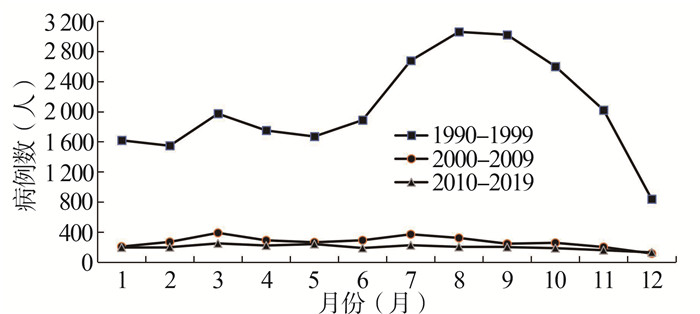Analysis on epidemiological characteristics of type A and B intestinal infectious diseases in Xinghua City from 1990 to 2019
-
摘要:
目的 探讨1990-2019年兴化市甲乙类肠道传染病发病趋势和流行特征,为制定其防控策略和措施提供依据。 方法 对兴化市1990-2019年甲乙类肠道传染病资料进行描述性分析。 结果 兴化市1990-2019年共报告甲乙类肠道传染病7种30 282例,年均发病率69.66/10万。1990-1999年、2000-2009年、2010-2019年平均发病率分别为161.30/10万、21.29/10万、18.35/10万,发病率呈下降趋势(x趋势2=56 574.719,P < 0.001)。1990-1999年甲肝、伤寒副伤寒高发,占总发病的78.58%,2000-2009年发病以肝炎(未分型)、甲肝为主,占65.87%,2010年后肝炎(未分型)、戊肝发病占69.81%。三个时期病人的性别和年龄组构成差异均有统计学意义(均有P < 0.05);农村和市区发病数分别占74.35%、25.65%,主要发病人群是农民、学生、散居儿童和工人;1990-1999年、2000-2009年发病呈明显双峰分布,高峰在每年3月和7-10月,2010-2019年季节性不明显,全年发病趋于平缓。 结论 1990-2019年兴化市甲乙类肠道传染病发病明显下降,防制效果显著;今后需加强对农村地区、农民、学生、散居儿童和中老年人的防控,结合新时期甲乙类肠道传染病的发病特点,采取综合性的干预措施 Abstract:Objective To explore the incidence trend and epidemic features of type A and B intestinal infectious diseases, and to provide scientific basis for prevention and control. Methods Data of type A and B intestinal infectious diseases reported in Xinghua from 1990 to 2019 were analyzed by descriptive epidemiology. Results A total of 30 282 cases with 7 categories of type A and B intestinal infectious diseases were reported in Xinghua from 1990 to 2019.The average annual incidence was 69.66 per 100 000 population. The incidence showed a decreasing trends (x2=56 574.719, P < 0.001) with 161.30 per 100 000, 21.29 per 100 000, and 18. 35 per 100 000 in the 1990-1999, 2000-2009, and 2010-2019 periods respectively.The main distribution of cases were hepatitis A and typhoid and paratyphoid in 1990-1999, unclassified hepatitis and hepatitis A in 2000-2009, and unclassified hepatitis and hepatitis E in 2010-2019. The constituent ratio was 78.58%, 65.87% and 69.81%, respectively. There were significant differences with the sex and ages between three decades. Additionally, the cases in rural and urban areas accounted for 74.35% and 25.65% while the majority of patients were farmers, students, scattered children and workers. The incidence peaked in March and July to October in 1990-1999 and 2000-2009, exhibiting a double peak distribution, while the seasonality of 2010-2019 was not obvious. Conclusions The effects were notable in category A and B intestinal infectious diseases control and prevention with the incidence rates have declined significantly in Xinghua City from 1990 to 2019. Therefore, it is essential to strengthen the supervision of intestinal infectious disease in rural areas as well as farmers, students, scattered children and the elderly. Combined with the characteristics of A and B intestinal infectious diseases in the new era, comprehensive prevention and control measures should be taken to reduce the incidence rate. -
Key words:
- Intestinal infectious diseases /
- Epidemic feature /
- Incidence
-
肠道传染病是由多种细菌和病毒感染引起的以肠道症状为主的传染性疾病,具有传播途径广、传播速度快、发病率高等特点,在世界范围内造成了众多死亡,是危害人类健康的全球性公共卫生问题之一[1]。
随着经济社会的发展、生活环境的改变,肠道传染病的流行趋势也产生了相应的变化,其中甲类肠道传染病(霍乱)已基本灭绝,但痢疾等乙类肠道传染病仍广泛流行,为新时期的防控工作带来挑战。为了解江苏省兴化市甲乙类肠道传染病的流行情况及变化趋势,为制定其有效的防控措施提供科学依据,现对1990-2019年兴化市报告的甲乙类肠道传染病发病数据进行阶段性汇总、分析,结果如下。
1. 资料与方法
1.1 资料
1990-2004年数据来自兴化市卫生防疫站历年法定传染病年报告卡,2005-2019年资料来自《中国疾病预防控制信息系统》中导出的传染病报表;统计的病种包括霍乱、甲型肝炎(简称“甲肝”)、戊型肝炎(简称“戊肝”)、肝炎(未分型)、细菌性痢疾、阿米巴性痢疾、伤寒副伤寒7种;人口数据参照兴化市统计年鉴。
1.2 统计学方法
采用Excel 2016软件对数据进行整理和制作图表,采用SPSS 20.0软件进行统计分析,定性资料采用频率描述,组间比较采用x2检验;采用Joinpoint Regression Program 4.6.0.0软件对各病种发病率进行时间趋势分析,计算年度变化百分比(annual percent change, APC), 并进行趋势检验。检验水准α=0.05。
2. 结果
2.1 流行概况
2.1.1 流行趋势
兴化市1990-2019年共报告甲乙类肠道传染病7种30 282例、死亡17例,年平均发病率69.66/10万,发病率总体呈下降趋势(x趋势2=56 574.719, P < 0.001)。1990-1999年发病数和发病率均急剧下降,2000-2009年,发病呈波动性状态,2010-2019年,发病呈逐渐下降趋势,三个时间段之间发病率的差异有统计学意义(x2=28 471.131, P < 0.001)。Joinpoint回归分析显示,1990-2019年兴化市甲乙类肠道传染病的发病率以每年13.0%的平均速率下降(t=-11.5, P < 0.001);其中甲肝APC为-18.6%(t=-12.1, P < 0.001), 肝炎(未分型)APC为-3.0%(t=-2.5, P < 0.001),细菌性痢疾APC为-11.7%(t=-8.5, P < 0.001),伤寒副伤寒APC为-23.5%(t=-28.5, P < 0.001)。甲肝、细菌性痢疾、伤寒副伤寒发病率下降趋势明显,其余甲乙类肠道传染病波动趋势不明显。
2.1.2 发病顺位
1990-1999年,兴化市甲乙类肠道传染病发病排前三的依次是甲肝、伤寒副伤寒、细菌性痢疾。2000-2009年,发病以肝炎(未分型)、甲肝、细菌性痢疾为主。2010-2019年,发病依次是肝炎(未分型)、戊肝、细菌性痢疾,共占发病总数的87.77%。见表 1。
表 1 1990-2019年兴化市7类甲乙类肠道传染病发病情况Table 1. The incidence of 7 kinds of type a and b intestinal infectious diseases in Xinghua City from 1990 to 2019病种 1990-1999年 2000-2009年 2010-2019年 发病数 发病率(/10万) 构成比(%) 发病数 发病率(/10万) 构成比(%) 发病数 发病率(/10万) 构成比(%) 霍乱 52 0.34 0.21 0 0.00 0.00 0 0.00 0.00 甲肝 10 202 66.71 41.36 1 028 6.8 31.93 247 1.89 10.31 戊肝 1 0.01 0.00 185 1.22 5.75 544 4.17 22.71 肝炎(未分型) 1 770 11.57 7.18 1 093 7.23 33.94 1 128 8.64 47.10 细菌性痢疾 3 217 21.04 13.04 533 3.52 16.55 430 3.29 17.95 阿米巴行痢疾 243 1.59 0.99 19 0.13 0.59 8 0.06 0.33 伤寒副伤寒 9 182 60.04 37.22 362 2.39 11.24 38 0.29 1.59 合计 24 667 161.30 100.00 3 220 21.29 100.00 2 395 18.35 100.00 2.2 人群分布
2.2.1 性别与年龄分布
1990-2019年全市报告的甲乙类肠道传染病中,男性病例18 466例,女性病例11 816例,男性年均发病率为82.25/10万,女性56.20/10万,发病率差异有统计学意义(x2=1 058.338,P < 0.001)。各年龄组均有发病,三个阶段的肠道传染病病人在不同性别、年龄组中的构成比差异均有统计学意义, 40岁以上的发病构成比分别为17.27%、60.96%、74.24%,平均增长率达107%,三个阶段的发病情况随着时间出现老年化趋势。见表 2。
表 2 1990-2019年兴化市甲乙类肠道传染病病人的性别和年龄分布[n(%)]Table 2. Gender and age distribution of type a and b intestinal infectious diseases in Xinghua City from 1990 to 2019 [n(%)]一般特征 1990-1999年 2000-2009年 2010-2019年 x2值 P值 发病数(人) 构成比(%) 发病数(人) 构成比(%) 发病数(人) 构成比(%) 性别 152.302 < 0.001 男性 14 651 59.40 2 250 69.88 1 565 65.34 女性 10 016 40.60 970 30.12 830 34.66 年龄(岁) 6 956.755 < 0.001 <10 6 036 24.47 190 5.90 147 6.14 10~ 4 446 18.02 197 6.12 64 2.67 20~ 6 559 26.59 334 10.37 166 6.93 30~ 3 351 13.58 538 16.71 240 10.02 40~ 2 039 8.27 605 18.79 516 21.54 50~ 1 236 5.01 617 19.16 483 20.17 60~ 737 2.99 447 13.88 504 21.04 70~ 237 0.96 243 7.55 216 9.02 ≥80 26 0.11 49 1.52 59 2.46 2.2.2 职业分布
1990-2019年报告发病构成最高的是农民(50.27%),其次为学生(15.77%),散居儿童(12.51%)和工人(7.13%)。
2.3 时间分布
时间分布1990-2019年,兴化市每月均有甲乙类肠道传染病病例报告,发病集中在7-10月份,累计发病数13 368例(44.15%)。1990-1999年、2000-2009年发病呈双峰分布,主高峰为7-10月,次高峰为每年3月份,2010-2019年发病无明显季节性,分布较为平均。霍乱、痢疾、伤寒副伤寒均为夏季高发;甲肝、戊肝、肝炎(未分型)每年3月发病上升,其余月份无明显高峰。见图 1。
2.4 地区分布
全市28个乡镇和街道均有甲乙类肠道传染病病例报告,其中城市地区7 767例(25.65%)、农村地区22 515例(74.35%),发病率差异有统计学意义(x2=615.018,P < 0.001)。主要发病地区为昭阳街道5 036例(16.63%),其次为沙沟镇2 202例(7.27%)、安丰镇1 794例(5.92%)和戴南镇1 750例(5.78%)。
3. 讨论
1990-2019年,兴化市甲乙类肠道传染病发病呈下降趋势,与江苏省其他地区肠道传染病的变化趋势相符合[2]。1990-1999年,兴化市甲乙类肠道传染病一直处于高流行状态(161.30/10万),发病以甲肝、伤寒副伤寒为主,与国内其他地区类似[3]。受地理位置影响,兴化市90年代洪涝灾害频发,肠道传染病的传播途径易于实现,且缺乏有效疫苗控制,导致发病率高居不下。2010-2019年,甲肝、伤寒副伤寒发病率较1990-2009年大幅下降,这主要得益于扩大免疫规划工作的深入开展,大大降低了甲肝的发病率,而饮用水卫生合格率的提高、生活环境的改善使得痢疾、伤寒副伤寒发病率控制在较低水平;戊肝、肝炎(未分型)发病率增长明显,成为威胁居民健康的主要肠道传染病,特别是戊肝,由于临床表现不明显,往往通过健康检查才能发现,病毒发现较晚,加之健康教育宣传普及不够,群众对其危害认识不足,导致发病率上升。
人群分布上,1990-1999年、2000-2009年和2010-2019年患者在不同性别、年龄的构成比差异均有统计学意义;男性发病高于女性,这与国内众多研究结果一致[4]。发病人群主要分布在农民、学生、散居儿童和工人。随着经济社会发展,健康知识的普及,青壮年外出务工、经商等,从事农业生产人员以中老年人为主,导致发病人数中成人和老年人所占比例逐渐上升。2010-2019年,发病人数中40岁以上年龄组占74.24%,说明中老年人逐渐成为甲乙类肠道传染病发病的高危人群。
兴化市1990-2019年1-12月份均有甲乙类肠道传染病发生,发病高峰主要集中在7-10月份,夏秋季高发,这与国内多数研究一致[5],夏秋季气温高、强降雨多、苍蝇和蚊虫滋生等危险因素增加了肠道传染病的发病风险[6-7]。2010-2019年,季节发病高峰不再明显,这主要得益于疫苗接种后大多数易感人群获得保护,同时经济社会的持续发展,健康教育和健康促进的普及,城市和农村供水系统的完善,卫生习惯的改变和防病意识的增强等因素有效预防和控制了肠道传染病的传播,导致发病人数和发病率均大幅度下降,流行高峰不再明显。
肠道传染病以粪口为主要传播途径,应采取以控制传染源、切断传播途径和保护易感人群为主的综合性防控措施[8]。虽然兴化市甲乙类肠道传染病发病呈现逐年递减的趋势,但导致肠道传染病的各种潜在危险因素广泛存在,对其监测和管理仍不能松懈,以便有效巩固肠道传染病的防制效果。下一阶段需加强农村地区的防控工作,特别是加大对农民、学生、散居儿童和中老年人群体的防治宣传,增强他们的防病意识和提高防病能力,确保饮用水和食物的安全、卫生。同时加强对病毒性肝炎的分型检测,做到早发现、早报告、早隔离、早治疗,并采取相应措施,防止引起疫情蔓延、扩散和暴发。
-
表 1 1990-2019年兴化市7类甲乙类肠道传染病发病情况
Table 1. The incidence of 7 kinds of type a and b intestinal infectious diseases in Xinghua City from 1990 to 2019
病种 1990-1999年 2000-2009年 2010-2019年 发病数 发病率(/10万) 构成比(%) 发病数 发病率(/10万) 构成比(%) 发病数 发病率(/10万) 构成比(%) 霍乱 52 0.34 0.21 0 0.00 0.00 0 0.00 0.00 甲肝 10 202 66.71 41.36 1 028 6.8 31.93 247 1.89 10.31 戊肝 1 0.01 0.00 185 1.22 5.75 544 4.17 22.71 肝炎(未分型) 1 770 11.57 7.18 1 093 7.23 33.94 1 128 8.64 47.10 细菌性痢疾 3 217 21.04 13.04 533 3.52 16.55 430 3.29 17.95 阿米巴行痢疾 243 1.59 0.99 19 0.13 0.59 8 0.06 0.33 伤寒副伤寒 9 182 60.04 37.22 362 2.39 11.24 38 0.29 1.59 合计 24 667 161.30 100.00 3 220 21.29 100.00 2 395 18.35 100.00 表 2 1990-2019年兴化市甲乙类肠道传染病病人的性别和年龄分布[n(%)]
Table 2. Gender and age distribution of type a and b intestinal infectious diseases in Xinghua City from 1990 to 2019 [n(%)]
一般特征 1990-1999年 2000-2009年 2010-2019年 x2值 P值 发病数(人) 构成比(%) 发病数(人) 构成比(%) 发病数(人) 构成比(%) 性别 152.302 < 0.001 男性 14 651 59.40 2 250 69.88 1 565 65.34 女性 10 016 40.60 970 30.12 830 34.66 年龄(岁) 6 956.755 < 0.001 <10 6 036 24.47 190 5.90 147 6.14 10~ 4 446 18.02 197 6.12 64 2.67 20~ 6 559 26.59 334 10.37 166 6.93 30~ 3 351 13.58 538 16.71 240 10.02 40~ 2 039 8.27 605 18.79 516 21.54 50~ 1 236 5.01 617 19.16 483 20.17 60~ 737 2.99 447 13.88 504 21.04 70~ 237 0.96 243 7.55 216 9.02 ≥80 26 0.11 49 1.52 59 2.46 -
[1] Mao Ying, Zhang Ning, Zhu Bin, et al. A descriptive analysis of the Spatio-temporal distribution of intestinal infectious diseases in China[J]. BMC Infectious Diseases, 2019, 19(1).DOI: 10.1186/s12879-019-4400-x [2] 姚建香, 马焰, 梁峰, 等. 2005-2014年江阴市甲乙类肠道传染病流行病学特征分析[J].现代预防医学, 2016, 43(12):2141-2144. http://www.cqvip.com/QK/97473X/201612/669283731.htmlYao JX, Ma Y, Liang F, et al. Analysis of the epidemiological characteristics of types A and B intestinal infectious diseases in Jiangyin City between 2005 and 2014[J]. Modern Preventive Medicine, 2016, 43(12):2141-2144. http://www.cqvip.com/QK/97473X/201612/669283731.html [3] 胡依红, 吴永. 1985年-2007年宁波市镇海区甲、乙类传染病疫情分析[J].河南预防医学杂志, 2009, 20(1):68-69. http://www.cnki.com.cn/Article/CJFDTotal-HNYF200901039.htmHu YH, Wu Y. Epidemiological featurs of type A and B intestinal infectious diseases in Zhenhai district of Ningbo from 1985 to 2007[J]. Henan J Prev Med, 2009, 20(1):68-69. http://www.cnki.com.cn/Article/CJFDTotal-HNYF200901039.htm [4] 张璟, 刘伟, 刘艳挪, 等.济宁市2009-2016年肠道传染病流行状况及疾病负担分析[J].中华疾病控制杂志, 2019, 23(2):217-222. doi: 10.16462/j.cnki.zhjbkz.2019.02.019Zhang J, Liu W, Liu YN, et al. Analysis on the epidemic status and the burden of intestinal infectious diseases in Jining city from 2009 to 2016[J]. Chin J Dis Control Prev, 2019, 23(2):217-222. doi: 10.16462/j.cnki.zhjbkz.2019.02.019 [5] 胡灿, 姚光海, 唐光鹏, 等.贵州省2008-2012年肠道传染病流行病学分析[J].中华疾病控制杂志, 2015, 19(1):42-45. doi: 10.16462/j.cnki.zhjbkz.2015.01.007Hu C, Yao GH, Tang GP, et al. Epidemiological analysis on the situation of intestinal infectious diseases in Guizhou Province, 2008-2012[J].Chin J Dis Control Prev, 2015, 19(1):42-45. doi: 10.16462/j.cnki.zhjbkz.2015.01.007 [6] Nicholas P. Sisto, Laura Maribel Colima Valadez, Ismael Aguilar Barajasl, et al. Infectious Intestinal Diseases and Residential Water Services in Mexico: a Spatial Analysis[J]. AIMS Geosciences, 2017, 3:450-466.DOI: 10.3934/geosci.2017.3.450 [7] Phung D, Chu C, Rutherford S, et al. Heavy rainfall and risk of infectious intestinal diseases in the most populous city in Vietnam.Sci Total Environ. 2017;580:805-812. Doi: 10.1016/j.scitotenv.2016.12.027 [8] 关静, 张燕, 宋静.北京市西城区2004-2012年肠道传染病流行病学分析[J].中国热带医学, 2014, 14(2):173-175. http://www.cnki.com.cn/Article/CJFDTotal-RDYX201402015.htmGuan J, Zhang Y, Song J. Epidemiological analysis of intestinal infectious diseases in Xicheng district of Beijing from 2004 to 2012[J]. Chin Trop Med, 2014, 14(2):173-175. http://www.cnki.com.cn/Article/CJFDTotal-RDYX201402015.htm 期刊类型引用(2)
1. 万丽,周小茜,王汐. 石家庄市2004—2022年肠道传染病流行特征分析. 现代预防医学. 2023(23): 4392-4397 .  百度学术
百度学术2. 廖雅芬,叶坚,杨业洲. 肇庆市涉农地区城乡饮用水水质与介水传染病相关性分析. 疾病预防控制通报. 2021(06): 44-48 .  百度学术
百度学术其他类型引用(0)
-





 下载:
下载:


 下载:
下载:

